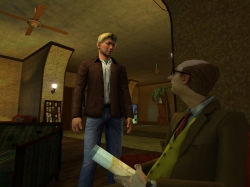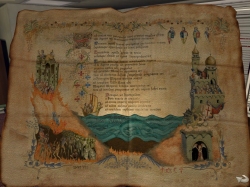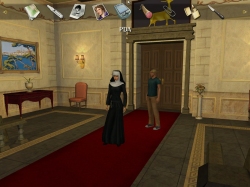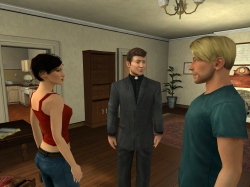|
Broken Sword: The Angel of Death / Secrets of the Ark
 Every now and then real life demands more than its fair share of attention, and so it had been nearly 6 weeks since I had mouse clicked in anything other than the pursuit of my employment. So it was with more than a little excitement that I set off once again with George Stobbart in this, the 4th instalment in the successful Broken Sword series launched just on 10 years ago.
It's a year in game time since George and Nico smote the Sleeping Dragon, and it hasn't been a great year for George. Now working as a bail bondsman in a less than salubrious enterprise, making ends meet is about as good as it seems to get. Then in walks Anna Maria.
It is giving nothing away to say that what follows is a globe trotting templar related treasure hunt, complete with medieval manuscripts, ruffians of all shapes and sizes, some old acquaintances and sassy banter. This is after all a Broken Sword.
No dragons this time, but an angel instead, one which is the key to divine power when mixed with a little science and the Ark of the Covenenant.
George must, of course, save the day. He could have stayed home, but when adventure and blondes come knocking, George never fails to answer the door. Every now and then real life demands more than its fair share of attention, and so it had been nearly 6 weeks since I had mouse clicked in anything other than the pursuit of my employment. So it was with more than a little excitement that I set off once again with George Stobbart in this, the 4th instalment in the successful Broken Sword series launched just on 10 years ago.
It's a year in game time since George and Nico smote the Sleeping Dragon, and it hasn't been a great year for George. Now working as a bail bondsman in a less than salubrious enterprise, making ends meet is about as good as it seems to get. Then in walks Anna Maria.
It is giving nothing away to say that what follows is a globe trotting templar related treasure hunt, complete with medieval manuscripts, ruffians of all shapes and sizes, some old acquaintances and sassy banter. This is after all a Broken Sword.
No dragons this time, but an angel instead, one which is the key to divine power when mixed with a little science and the Ark of the Covenenant.
George must, of course, save the day. He could have stayed home, but when adventure and blondes come knocking, George never fails to answer the door.
George is once again voiced by Rolfe Saxon, who rings no bells for me other than he has been George since day one. The continuity brings not only a familiarity, but helps ground the series in its central character and cement the feeling that this is indeed a continuation. It helps, too, that Rolfe is excellent.
 It also helps that the dialogue is again sharp and sassy. It's always a fine line between silly and witty, daft and clever, and humour is as always a personal thing. For me though, Broken Sword: The Angel of Death walked that line admirably. There was some banter that had me laughing out loud, other dialogue that scored a most palpable sarcastic hit. Not everything humorous was funny (and not everything funny was spoken) and George and the Angel have their serious and dramatic moments, but all up it's a well put together mix.
The other characters, some of them familiar if you have played the earlier games, all play their part rather well. Nico gets a new voice yet again, and perhaps a bigger bust, but is a good foil for George. I found her more interesting this time, and getting to play as Nico for an extended sequence towards the end of the game was a plus. Some characters are a little stereotypical but that to me is part of the construct. Father Mark was a standout, and Archie was probably the only redundant one.
It would have been nice to have a few more non playing characters. Despite being in Paris and Istanbul, people not essential to the exploits pretty much don't exist. In fact, it was largely what wasn't there that was one of the negatives in Angel of Death.
Also, the canvas on which the game is played lacked an attention to detail that overall made it seem both a little flat and certainly less polished. It was like a movie shot at 26 frames a second with every 10th and 20th frame removed. A mirror in the back of a restaurant reflects perfectly what is going on, even out of scene, yet George walks down a path in which the hedges cast shadows but he doesn't. You need to walk George around an obstacle in his way, yet at times Nico passes straight through George, or his feet sink into the edges of stairs. You have to sensibly be out of sight of a character before forging a document he desires, but you can't hack a computer network whilst standing by yourself outside the building but are forced instead to go and stand in a completely unrelated location. Hair can bounce, but some drawers open by gesturing in their direction.
You will notice other things like this as you play. It's all the more pronounced because, for instance, George's shadow in many scenes is perfectly done. So the other 24 frames are excellent, but the two that are missing stand out. It also helps that the dialogue is again sharp and sassy. It's always a fine line between silly and witty, daft and clever, and humour is as always a personal thing. For me though, Broken Sword: The Angel of Death walked that line admirably. There was some banter that had me laughing out loud, other dialogue that scored a most palpable sarcastic hit. Not everything humorous was funny (and not everything funny was spoken) and George and the Angel have their serious and dramatic moments, but all up it's a well put together mix.
The other characters, some of them familiar if you have played the earlier games, all play their part rather well. Nico gets a new voice yet again, and perhaps a bigger bust, but is a good foil for George. I found her more interesting this time, and getting to play as Nico for an extended sequence towards the end of the game was a plus. Some characters are a little stereotypical but that to me is part of the construct. Father Mark was a standout, and Archie was probably the only redundant one.
It would have been nice to have a few more non playing characters. Despite being in Paris and Istanbul, people not essential to the exploits pretty much don't exist. In fact, it was largely what wasn't there that was one of the negatives in Angel of Death.
Also, the canvas on which the game is played lacked an attention to detail that overall made it seem both a little flat and certainly less polished. It was like a movie shot at 26 frames a second with every 10th and 20th frame removed. A mirror in the back of a restaurant reflects perfectly what is going on, even out of scene, yet George walks down a path in which the hedges cast shadows but he doesn't. You need to walk George around an obstacle in his way, yet at times Nico passes straight through George, or his feet sink into the edges of stairs. You have to sensibly be out of sight of a character before forging a document he desires, but you can't hack a computer network whilst standing by yourself outside the building but are forced instead to go and stand in a completely unrelated location. Hair can bounce, but some drawers open by gesturing in their direction.
You will notice other things like this as you play. It's all the more pronounced because, for instance, George's shadow in many scenes is perfectly done. So the other 24 frames are excellent, but the two that are missing stand out.
 Those of you that lamented the exclusive keyboard control of Sleeping Dragon will be pleased to know that you can use the mouse or the keyboard in Angel of Death. I confess to using the mouse almost exclusively given the somewhat messy orientation when using the keyboard commands. The mouse wasn't perfect either, and a lack of ability to force the camera perspective to change resulted in a tendency to have to click incessantly in front of George to get him to move a matter of microns at a time until the camera moved to give you a broader focus. This could be overcome to some degree by holding down the mouse key and dragging the cursor in front of George, and certainly saved on finger fatigue, but a swift change of camera angle resulted, at times, in some interesting pirouettes and wall banging.
You also can't set George's perambulation default to "run". You could make George run simply by using the mouse wheel, but every interaction made him walk again. Perhaps he simply got tired.
Like any movement system you settle in as you play, and overall it was an occasional irritant rather than a major pain. Camera movement is also generally done smoothly and effectively, adding to the cinematic feel of the cutscenes in particular.
So too the music heightens the tension and adds to the events. I didn't notice it except when it seemed I was meant to, which suggests it was admirably done.
There is a good variety of puzzles and conundrums. Many are situational, and inventory items abound. Access the inventory by the simple task of moving the cursor to the top of the screen. All the items appear and George can examine them and combine them, although taking some apart will often be far more important. Right click to examine and have George describe them, left click to use. You side scroll the inventory when it gets too full for the screen.
Talking to characters works in much the same way. Click on a character when a mouth icon appears, and topic icons will appear at the bottom of the screen. Choose your item of interest and have at it. You can't, however, skip any dialogue, another minor irritant if you have heard it before.
Interactions are indicated by a small array of icons (look, use, search) and hotspots are fairly large and generous, if a little crowded at times. It's all rather uncomplicated, and will be familiar to many players. Those of you that lamented the exclusive keyboard control of Sleeping Dragon will be pleased to know that you can use the mouse or the keyboard in Angel of Death. I confess to using the mouse almost exclusively given the somewhat messy orientation when using the keyboard commands. The mouse wasn't perfect either, and a lack of ability to force the camera perspective to change resulted in a tendency to have to click incessantly in front of George to get him to move a matter of microns at a time until the camera moved to give you a broader focus. This could be overcome to some degree by holding down the mouse key and dragging the cursor in front of George, and certainly saved on finger fatigue, but a swift change of camera angle resulted, at times, in some interesting pirouettes and wall banging.
You also can't set George's perambulation default to "run". You could make George run simply by using the mouse wheel, but every interaction made him walk again. Perhaps he simply got tired.
Like any movement system you settle in as you play, and overall it was an occasional irritant rather than a major pain. Camera movement is also generally done smoothly and effectively, adding to the cinematic feel of the cutscenes in particular.
So too the music heightens the tension and adds to the events. I didn't notice it except when it seemed I was meant to, which suggests it was admirably done.
There is a good variety of puzzles and conundrums. Many are situational, and inventory items abound. Access the inventory by the simple task of moving the cursor to the top of the screen. All the items appear and George can examine them and combine them, although taking some apart will often be far more important. Right click to examine and have George describe them, left click to use. You side scroll the inventory when it gets too full for the screen.
Talking to characters works in much the same way. Click on a character when a mouth icon appears, and topic icons will appear at the bottom of the screen. Choose your item of interest and have at it. You can't, however, skip any dialogue, another minor irritant if you have heard it before.
Interactions are indicated by a small array of icons (look, use, search) and hotspots are fairly large and generous, if a little crowded at times. It's all rather uncomplicated, and will be familiar to many players.
 I made passing mention of the puzzles in Broken Sword: The Angel of Death, but what of them in more detail? As noted, many are situational, in keeping with the previous games. On many occasions, the options are limited, particularly in location, so novice players need not fret. There are some larger locations, the salami factory and the phoenix laboratory being two of them, where you might find yourself searching for items or solutions over a much bigger area. The mix is good, and limited doesn't mean dull or straightforward. Getting George untied from the chair in the Black Cat club is a classic example.
Scattered amongst these are some straight puzzles, predominantly in two sequences involving the translation of manuscripts. These require some lateral and logical thinking, although a little trial and error might help. The manuscripts are carried with you, so you won't need to worry that you should have drawn something you didn't. You might, though, be helped by paying attention to the environment as well — not every answer is in the document.
There are a number of hacking puzzles, which are little mini games within the game. They added a high tech dimension to the ancient goings-on. Maybe there could have been one or two less, but they were an explicable part of the plot and a different diversion.
If you have crate phobia from the Sleeping Dragon, then you can relax. There is a great little piece of self deprecation with a room full of crates, and while you do push a few around it is very limited. Action sequences, too, are kept to a minimum and do not involve complicated and harassed manipulations. If you have to jump a gap, click on the other side and the character will jump it. If you have to climb, an icon will appear and using it will make the character climb, perhaps with some further clicking to tell him or her whereabouts to go. You have to dodge some alarm beams in one part, but it is simply a matter of waiting for them to go off, then move past with plenty of time. So it's action in the most limited sense.
You do have to sneak once or twice, and the end part of one particular sneak across a garden deserves to have a chair thrown at it. Having said that, and having cheated to find out what I was doing wrong (and which I doubt I would have worked out), I quite enjoyed distracting the guards and the monks. You will probably be caught a few times to work out the way past some guards, but it rarely held me up for long. Not knowing what to do was far more likely to be the reason for being stuck rather than not being able to do it.
George can die (indeed I blew him completely to pieces with semtex) but is more likely to be caught, but the game simply returns you to the beginning of that particular sequence. Some sequences have a timed aspect, but not many. Disarming the bomb was the most difficult in terms of the time factor, given it involved a computer hack to obtain the relevant information. By that time though, you have completed 4 or 5 hacks so have had a little practice. On other occasions the sense of urgency suggested is simply to provide a little dramatic frisson; there is actually no need to hurry at all. I made passing mention of the puzzles in Broken Sword: The Angel of Death, but what of them in more detail? As noted, many are situational, in keeping with the previous games. On many occasions, the options are limited, particularly in location, so novice players need not fret. There are some larger locations, the salami factory and the phoenix laboratory being two of them, where you might find yourself searching for items or solutions over a much bigger area. The mix is good, and limited doesn't mean dull or straightforward. Getting George untied from the chair in the Black Cat club is a classic example.
Scattered amongst these are some straight puzzles, predominantly in two sequences involving the translation of manuscripts. These require some lateral and logical thinking, although a little trial and error might help. The manuscripts are carried with you, so you won't need to worry that you should have drawn something you didn't. You might, though, be helped by paying attention to the environment as well — not every answer is in the document.
There are a number of hacking puzzles, which are little mini games within the game. They added a high tech dimension to the ancient goings-on. Maybe there could have been one or two less, but they were an explicable part of the plot and a different diversion.
If you have crate phobia from the Sleeping Dragon, then you can relax. There is a great little piece of self deprecation with a room full of crates, and while you do push a few around it is very limited. Action sequences, too, are kept to a minimum and do not involve complicated and harassed manipulations. If you have to jump a gap, click on the other side and the character will jump it. If you have to climb, an icon will appear and using it will make the character climb, perhaps with some further clicking to tell him or her whereabouts to go. You have to dodge some alarm beams in one part, but it is simply a matter of waiting for them to go off, then move past with plenty of time. So it's action in the most limited sense.
You do have to sneak once or twice, and the end part of one particular sneak across a garden deserves to have a chair thrown at it. Having said that, and having cheated to find out what I was doing wrong (and which I doubt I would have worked out), I quite enjoyed distracting the guards and the monks. You will probably be caught a few times to work out the way past some guards, but it rarely held me up for long. Not knowing what to do was far more likely to be the reason for being stuck rather than not being able to do it.
George can die (indeed I blew him completely to pieces with semtex) but is more likely to be caught, but the game simply returns you to the beginning of that particular sequence. Some sequences have a timed aspect, but not many. Disarming the bomb was the most difficult in terms of the time factor, given it involved a computer hack to obtain the relevant information. By that time though, you have completed 4 or 5 hacks so have had a little practice. On other occasions the sense of urgency suggested is simply to provide a little dramatic frisson; there is actually no need to hurry at all.
I got an error message once or twice and as a result the game aborted to the desktop, and I had to lower the sound acceleration to basic in order to stop the dialogue simply dropping out (this was in the readme file). Again, it's a component of the attention to detail. My version was on DVD so there was no disk swapping, and configuration options were available for many parameters, including subtitles. There were a lot of splash screens at the start but they could be skipped, and loading and saving is easy and unlimited.
The game is a good length, and whilst the end comes quickly I thought it was a good climax. There are some plot holes (caverns really) but what boy's own adventure doesn't have those? It's part of the charm.
Broken Sword: The Angel of Death gave me a lot of enjoyment. Part of that was familiarity, part was the absence of game playing for some time, and much was simply because it was a decent product. Had those missing frames been included, this may well have been top notch. As it is, it was a damn fine fortnight of adventure, and George will no doubt be back on the strength of it.
Note: The Adventure Company released this title in North America in 2007 as Secrets of the Ark: A Broken Sword Game.
Copyright © Steve Ramsey 2006.
All rights reserved.
System Requirements:
WindowsXP. Pentium 4 1.4 GHz or better, 256 MB RAM (512 MB recommended), 2.6 GB disc space, 2x DVD ROM, Nvidia GeForce 6200 or 128 MB Shader model or better, DirectX 9.0c (included on DVD), Windows sound card.
|

